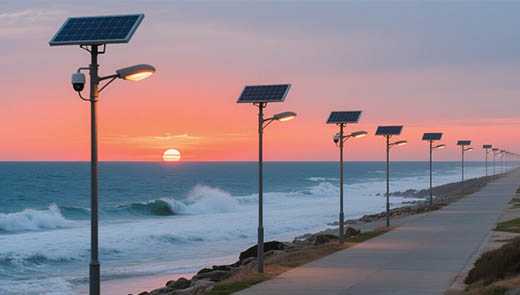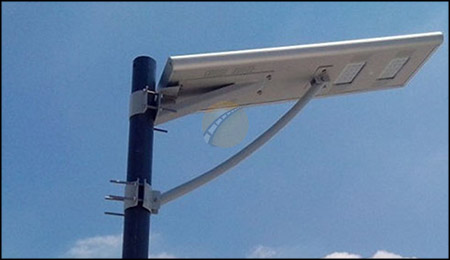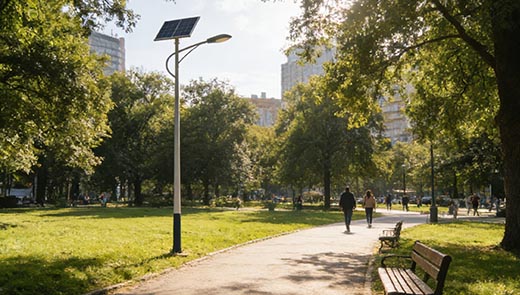How Solar Street lights Contribute to Sustainable Urban Development
At a time of rapid global urbanization, the share of energy consumption in cities has exceeded 70%, and the problem of carbon emissions is becoming more and more acute, seriously constraining the sustainable development of cities. Against this backdrop, solar street lights have emerged as a key force in the green transformation of cities due to their clean and renewable nature.
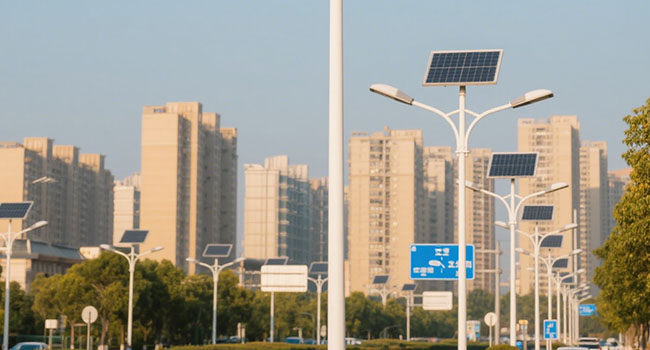
Understanding Solar Street lights
The working principle of solar street lights is based on advanced photovoltaic conversion technology. Its core component, the photovoltaic panel, is made of a special semiconductor material. When the sun shines, photons hit the electrons in the semiconductor, causing them to gain energy to form electrons, which generate electric current under the action of the internal electric field, converting solar energy into electric energy. This power is stored in the battery through the charge controller and drives the LED lights at night. Even on cloudy days, the efficient energy storage and circuit design ensure stable lighting at night.
Key Components
|
Component Name |
Function |
Importance |
|
LED Light |
High luminous efficiency, low energy consumption, long lifespan; efficiently converts electrical energy into light |
Directly determines lighting performance and energy consumption; reduces lamp replacement costs |
|
Charging Controller |
Intelligently regulates battery charging and discharging to prevent overcharging or overdischarging |
Protects the battery and extends the lifespan of the streetlight |
|
Sensor |
Light sensor detects brightness to control switching; motion sensor detects moving objects |
Enables automatic switching and smart dimming, saves energy and enhances safety |
|
Lamp Pole |
Made of high-strength materials with wind and earthquake resistance; optimized height and angle ensure best lighting coverage |
Ensures stable installation and operational safety; optimizes lighting coverage and performance |
Solar Street lights vs. Traditional Lights
Installation Costs
There is a clear difference between solar street lights and traditional lights in terms of initial capital investment in infrastructure. Solar street lights require core equipment such as solar panels, storage batteries, intelligent controllers, etc., and the upfront installation cost for a single street light usually ranges from $400 - $700. These equipments not only require professional procurement channels, but also involve complex installation and commissioning processes, especially the orientation angle of the solar panel, the reasonable configuration of the battery, etc., which all require professionals to carry out accurate installation, thus increasing the initial cost.
On the contrary, the initial installation cost of traditional streetlights is relatively low, with the price of a single lamp around 130 - 270 USD, mainly focusing on the lamps, poles and basic circuit connections. However, traditional streetlights rely on the city grid for power, and during the actual installation process, a large number of cables need to be laid to connect the streetlights to the grid. In areas with long road mileage and complex terrain, the cost of cable laying rises dramatically, and the cost per kilometer of cable laying and associated power additions can run into the thousands of dollars, increasing the overall cost of the installation dramatically, even more than the initial investment in the solar streetlights.
Operation Costs
The cost difference between the two is even more prominent during the daily operation phase of the streetlight. Solar streetlights use free solar energy as their energy source and incur almost no electricity expenses. The annual maintenance cost is mainly focused on cleaning and maintenance of the equipment and occasional parts overhaul, with an average annual maintenance cost of about 7 - 14 USD.
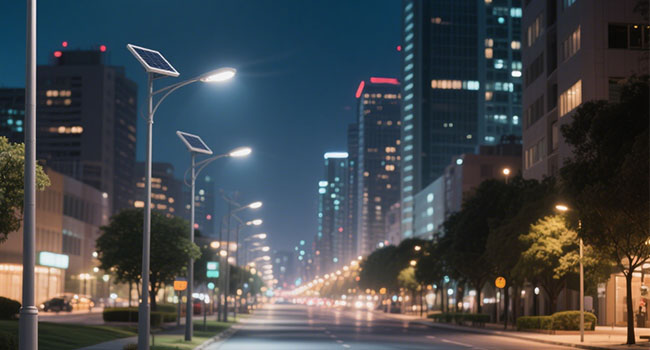
Conventional streetlights rely on grid power. For a 100-watt streetlight with an average of 10 hours of daily illumination, the annual cost of electricity is about US$36.5 per light at US$0.1 per kWh. In addition, traditional street lights require regular replacement of bulbs and overhaul of aged wiring, with an annual maintenance cost of about US$20-34. Taken together, the annual operating cost of a traditional street light is about 56.5 - 70.5 USD, which is several times higher than the operating cost of a solar street light.
Long Term Benefits
The advantages of solar streetlights are further apparent when the costing is done over a 10-year life cycle. Its storage battery life is generally 5 - 8 years, and the LED lamp life is more than 10 years, even taking into account the battery replacement cost (about 80 - 120 USD / time), the total comprehensive cost of 10 years is about 600 - 900 USD. In 10 years, traditional streetlights not only have to bear the cost of electricity, but also need to replace bulbs frequently (about every 2-3 years, each time 20 - 30 dollars), overhauling the line, the total cost of electricity and maintenance for 10 years can reach 800 - 1000 dollars, far more than the solar streetlights.
Environmental Impact
There is a stark contrast between the two in terms of environmental impact. Traditional streetlights rely on fossil fuels to generate electricity, and each streetlight produces about 1 ton of carbon dioxide emissions per year, while also releasing pollutants such as sulfur dioxide and nitrogen oxides, exacerbating air pollution. Solar street lights use clean and renewable solar energy to achieve zero carbon emission in the whole life cycle. Each installation of solar street lights is equivalent to reducing carbon dioxide emission by 1 ton per year, which is of irreplaceable significance in improving urban air quality and promoting green and low-carbon development.
Solar Street Lights and Urban Development
Reducing Carbon Footprints and Promoting Clean Energy
In the context of the global response to climate change, traditional street lights rely on fossil fuels to generate electricity, which is an important source of carbon emissions in cities. According to the International Energy Agency (IEA), for every kilowatt-hour of electricity consumed by conventional power systems, an average of 0.8 to 1 kilogram of carbon dioxide is produced. A city with a population of one million with 100,000 traditional streetlights would emit 100,000 tons of carbon per year.
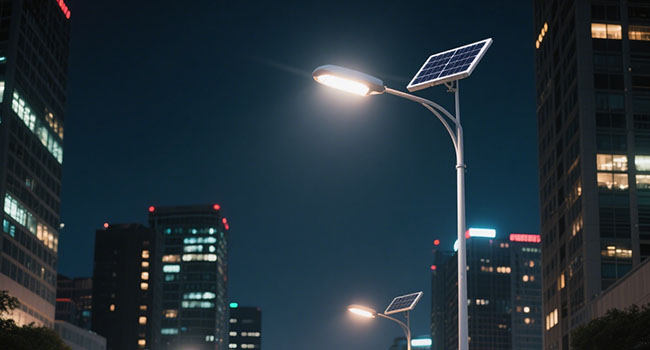
Solar street lights use solar energy as the energy source, realizing zero emission in the whole life cycle. Compared with traditional street lights, they do not require long-distance transmission lines, which reduces the loss of 8% - 15% in the process of power transmission. With the advancement of photovoltaic technology, the conversion efficiency of solar streetlights has increased from 12% in the early days to 25% nowadays, which further reduces the city's dependence on fossil energy and accelerates the transition of energy structure to clean energy.
Enhancing Public Safety and Security in Urban Areas
Good lighting at night is a guarantee of public safety. Studies have shown that crime rates in well-lit areas are about 30% lower than in dimly lit areas. Solar streetlights use high-brightness LED light sources, which provide a wider range of illumination and more uniform brightness, reducing the rate of nighttime traffic accidents on roadways by about 25%. Intelligent sensors realize the dynamic lighting of “lights on when people come and lights off when people leave”. In parks, squares and other areas, when pedestrian activity is detected, the street lamps automatically increase the brightness; when people leave, the brightness is automatically reduced. This intelligent adjustment not only ensures safety, but also saves 30% - 40% of electricity, while attracting more people to participate in nighttime activities and enhancing urban vitality.
Supporting Off-Grid and Remote Areas
About 1.2 billion people in rural areas of developing countries and remote mountainous areas of developed countries still face power shortages. Traditional power grids are expensive to build, costing $50,000 - $100,000 per kilometer of transmission line. Solar streetlights can operate independently without the need for complex grids. In villages on the edge of the Sahara Desert in Africa, after the installation of solar street lights, the safety of villagers traveling at night has been guaranteed, and the rate of traffic accidents has dropped by 60%. Meanwhile, the improved lighting has also given rise to night bazaars, where villagers can sell their agricultural products to neighboring towns and cities, increasing the annual income of each household by an average of 1,500-2,000 U.S. dollars, and effectively promoting local economic development.
Promoting Technological Innovation and Smart City Development
The solar street light integrates Internet of Things (IoT), Big Data, Artificial Intelligence and other technologies. Through the IoT module, managers can monitor the working status of each streetlight in real time, shortening the response time from 24 hours in the past to less than 2 hours. Big data analysis can optimize the street light layout and lighting strategy. By collecting data on light intensity, pedestrian and vehicle traffic, the system can automatically adjust the brightness and switching time of streetlights. Artificial intelligence image recognition technology can also monitor waterlogging and garbage accumulation on roads, realizing “one light for multiple uses” and helping to build a smarter and more efficient urban management system.
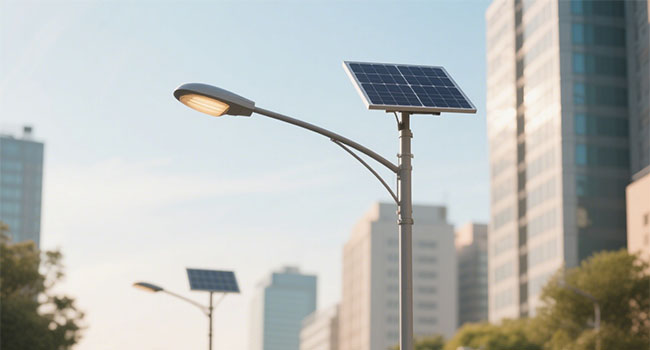
The Challenges and Opportunities of Solar Street Lights
Current Challenges in Widespread Adoption of Solar Street Lights
In the process of promoting solar street lights, the first thing is to face the cost pressure. The initial cost of solar panels, batteries and other equipment is 30% - 50% higher than that of traditional street lights, which makes it more difficult for small and medium-sized cities and towns with limited capital to promote them. Secondly, environmental factors also have constraints on the use of solar street lights, in high latitude, cloudy or rainy weather areas, the solar panel power generation efficiency will be affected, for example, some areas in the UK solar street lights at night lighting hours may be shortened by 20% - 30%.
There are also shortcomings in technology. The cycle life of ordinary lead-acid batteries is only 3-5 years, and there is also the problem of light degradation under extreme temperatures, and the intelligent control system also has occasional failures. In addition, some people do not understand the technical principles of solar street lights, and there are misunderstandings such as “it can't work in cloudy and rainy days”, so they are resistant to installing solar street lights.
Opportunities for Innovation and Growth in the Solar Street Light Industry
The solar street light industry is also facing many development opportunities. At the technological level, the photoelectric conversion efficiency of calcite solar cells has exceeded 25%, new types of batteries such as graphene batteries have improved energy storage density and life span, and the application of Internet of Things (IoT) technology has realized intelligent management. In terms of market, the global population of about 1.3 billion people in areas with huge demand for power shortage, and the construction of smart cities in developed countries is also promoting the development of solar street lights in the direction of intelligence. At the same time, governments have introduced subsidies, incentives, industry chain upstream and downstream enterprises collaborate to effectively reduce production costs, improve product quality, for the widespread application of solar street lights provide strong support.
Solar streetlights are of great significance to the sustainable development of cities in terms of reducing carbon emissions, enhancing public safety and promoting technological innovation. Despite the challenges, with the technological progress and cognitive enhancement, it will certainly play a greater role in urban construction.

